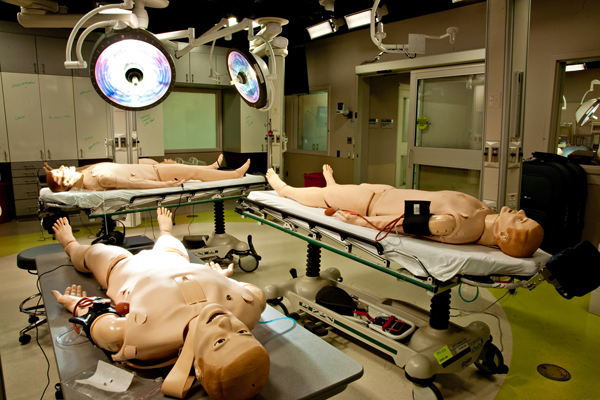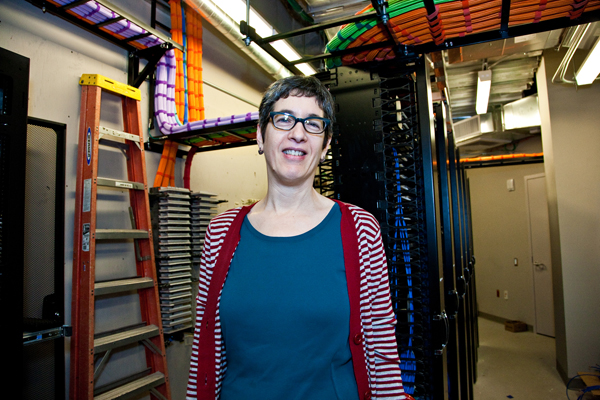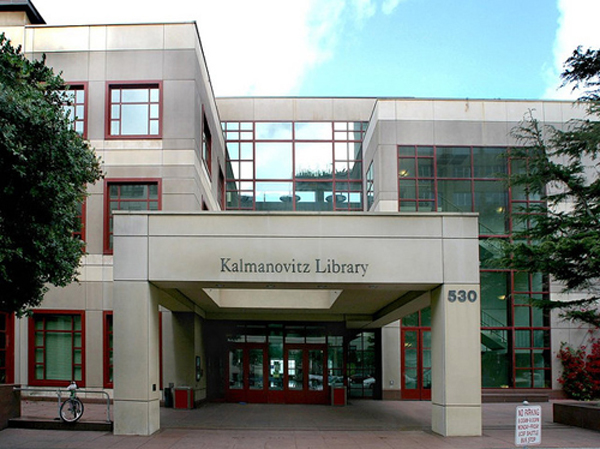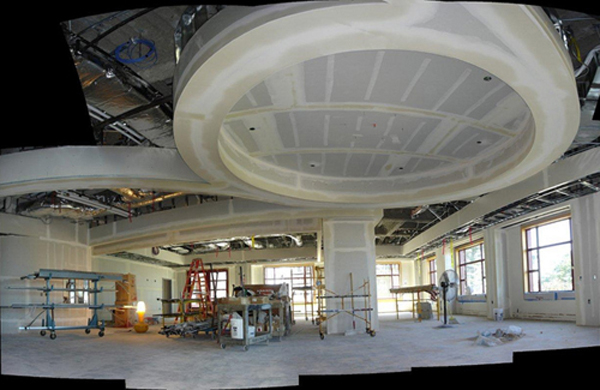
The Teaching and Learning Center will provide simulation-based clinical training using advanced patient simulators that are anatomically realistic and functional.
The technology-rich Teaching and Learning Center opens its doors today (Jan. 18) to the campus community for weeklong activities marking a new era in interprofessional health education and telemedicine at UCSF.
Located on the second floor of the Kalamanovitz Library on the Parnassus campus, the 22,000-square-foot educational center is dedicated to creating a culture of collaboration through a flexible learning environment comprised of three main areas: technology-enhanced classrooms; a training center that provides instruction in simulation-based clinical training and telemedicine and a technology commons.
“This is the newest and most significant investment in an educational facility that promotes interprofessional health education at UCSF,” says Joseph Castro, PhD, vice chancellor for Student Academic Affairs. “Patient care, education and discovery are the Chancellor’s three priority areas of focus and this center is one example of how we’re fulfilling the vision of providing a world-class education to the next generation of leaders in the health sciences.”
Open House Activities
The Teaching and Learning Center opens today on the UCSF Parnassus campus.
Take a tour. Explore technology. Join UCSF Chancellor Sue Desmond-Hellmann at the dedication ceremony at noon, Jan. 18.
Find out more here.
As a central hub for students from the all four professional schools of dentistry, medicine, nursing and pharmacy, the physical therapy program; and, over time, from the Graduate Division, the Teaching and Learning Center is the result of a collaborative planning process that drew representatives from across the University.
The center will serve as a primary venue for the new Center for Excellence in Interprofessional Health Education, which was recently initiated by Chancellor Sue Desmond-Hellmann, MD, MPH. This center will coordinate existing and stimulate new initiatives to collaboratively advance patient care, public service and research.
“We hope that some of the most innovative interprofessional education goes on here,” says Kevin Souza, MS, assistant dean for Medical Education at the UCSF School of Medicine.
Reflecting a Vision for Modern Learning
The new Teaching and Learning Center adds 11 more classrooms to the existing 55, helping the campus expand critical educational space to serve more than 2,500 students a year. All 11 new classrooms are adaptable to student and faculty needs and were designed for interactive, small group learning. Soundproof sky walls can be raised and lowered to change the size of rooms depending upon the amount of space needed.
Small groups can work together at “pods” of desks, each equipped with flat panel TV screens for projecting students’ work. Individual pods’ screens can be projected on all of the monitors in the room, in addition to adjacent rooms, enabling one group of students to reach others through classroom walls.

Gail Persily, director of Education and Public Service, at the UCSF library, stands in the server room at the new Teaching and Learning Center on the Parnassus campus.
“Smart classrooms are really an exciting way for us to develop more student-centered teaching strategies for our students to work in small groups,” says Dorothy Perry, PhD, associate dean for Education and Student Affairs at the School of Dentistry. “In these classrooms they have to explore the web, solve problems in a group environment and do things we expect them to do when they’re out of school rather than listen to lectures.”
Faculty from all of the professional schools was consulted from the conception of the design to implementation of the new curriculum. “It reflects what their vision for education is going forward,” Souza says.
Two faculty-led committees were created to work on developing the curriculum that will be taught in the new facilities: one focused on developing simulation, clinical skills and telemedicine education and the other focused on exploring innovative uses of the classrooms.
Classes at the Teaching and Learning Center start January 24, and the curriculum will bring together students from each of the professional schools to diagnose and treat simulated patients using the latest tools and technology.
“The underlying philosophy is that the quality and effectiveness of patient care will be higher if it’s done in an interprofessional approach,” says Castro. “Team-based learning from across the different schools and Graduate Division is expected to make a great difference.”
Gaining Skills Through Simulation
In the clinical simulation center, live interactions and consultations can be staged and projected on screens for other students to watch and learn.
As the students are interviewing a patient or practicing a physical exam or dental exam, it can be watched in real time by a faculty preceptor and the recording software allows the faculty member to annotate the activity.
“Afterwards, the student can sit down with the faculty member and review the recording and jump to the points where the comments are or watch the whole thing,” said Souza. In addition, all of this video is stored on web servers and students can log in and access their training videos with faculty comments.
The videos also allow students to observe their own interactions in a clinical setting. “It gives you a chance to reflect on your own work and think for yourself about what you didn’t do well and what you can improve upon,” says Perry. “We find that’s very valuable.”

The Kalmanovitz Library on the Parnassus campus is home to the new Teaching and Learning Center, the hub for interprofessional health education at UCSF.
In the 12 mock exam rooms, students examine “patients” played by actors. Each pair of rooms can also be converted to a larger room, where a gurney or patient bed can be brought in for a mannequin-based simulation.
But it’s in the largest simulation suites where the most impressive technology takes place. As part of an emergency power outage simulation, two infrared cameras record students in darkness as they treat patients in a disaster-like situation. The room is designed like a broadcast studio, where cameras, microphones and lights can be moved around and configured into new scenarios.
The main attraction of the four-bed inpatient unit is the Sim people: $80,000 mannequins that have heartbeats, can be intubated, can go into shock and even shed tears.
“Many of the trainings in the simulation center are not about the procedures they’re practicing,” says Souza, “but how they work as a team and communicate with each other.”
Employing Advanced Technology
Through the Teaching and Learning Center, students from diverse health professional disciplines will be prepared to use telemedicine to communicate with their counterparts at clinics across San Francisco and the state. “Our students will learn how to do it here and then practice it when they’re out in the clinics,” said Souza.
With seven classrooms outfitted for telemedicine and six examination room carts equipped with a complete mobile video conferencing system, students will be trained to treat patients they never could have reached in past due to geographical constraints.
Expanding its training in telemedicine consultation ensures that UCSF’s health sciences expertise can reach communities that need care, especially underserved populations. In fact, the $15.5 million cost of the Teaching and Learning Center was funded by the state through Proposition 1D, a 2006 voter-approved education bond that placed special emphasis on improving health care for underserved populations in California.
The center’s technology commons encourages students to study and work in small groups while having the power of advanced technology at their fingertips. The commons includes a 24-seat computing classroom equipped with partitions to change the dimensions of the space. Students and faculty have access to six work stations for digital media development as well as a multipurpose media room equipped with a camera, podium, and audio/video editing software to create and practice presentations.
Moving to Digital Technology
Transforming the second floor of the Parnassus campus library into a cutting-edge learning center heralds a new future for the library. It meant letting go of many of the journals and books that were shelved on the floor for decades. Some 44 bookcase ends were salvaged during demolition and reused in the main corridor, one of many sustainable features in the project that is pending Leadership in Energy and Environmental Design (LEED) certification with the U.S. Green Building Council.
According to Karen Butter, University Librarian and assistant vice chancellor, more than 117,000 bound volumes on the second floor were relocated to make room for the new facility.
“When we think about moving into a digital environment it means opening the library doors to anyone in the UCSF community regardless of their physical location.”

From demolition through construction, the 22,250-square-foot Teaching and Learning Center project took nearly 300 days to complete.
The Teaching and Learning Center will expand upon the library’s important role in health sciences education in part by fostering new initiatives with faculty, staff and students, Butter said.
“We have really strong partnerships with all of the schools, for example, we work closely with the School of Dentistry, particularly in developing its online curriculum,” Butter says, “so building upon our strengths in education and partnering with the faculty and students who will be here using the TLC offers opportunities to expand the library’s program and services that enrich UCSF’s educational initiatives.”
Butter and key library representatives became involved early on with planning for the Teaching and Learning Center back in 2004 because the library really has been the heart of education on the Parnassus campus, said Souza. “In order to understand that presence and the leadership [the library staff] provided us, it was essential that they were involved in those conversations.”
Advancing Health Care
The many benefits of the Teaching and Learning Center, while located at the Parnassus campus, will reverberate across the entire UCSF community. “I think what’s so special about UCSF is we do have four health professional schools, plus the physical therapy program, located on this small campus in a very concentrated way,” says Souza.
And while the schools have always worked together, Souza says “Now we have a way to focus that training and have such a great opportunity to take advantage of what we all do really well.”
The Teaching and Learning Center will host four days of tours, demonstrations and workshops to launch the state-of-the-art interprofessional health teaching and learning facilities. The dedication ceremony is scheduled for Tuesday, Jan. 18 from noon to 1 p.m.
During the center’s opening week, faculty, staff, students and trainees are encouraged to stop by to see innovative teaching and learning in action.
Photos (except Kalmanovitz Library and construction) by Susan Merrell
Related Links
 The Teaching and Learning Center will provide simulation-based clinical training using advanced patient simulators that are anatomically realistic and functional.
The Teaching and Learning Center will provide simulation-based clinical training using advanced patient simulators that are anatomically realistic and functional. Gail Persily, director of Education and Public Service, at the UCSF library, stands in the server room at the new Teaching and Learning Center on the Parnassus campus.
Gail Persily, director of Education and Public Service, at the UCSF library, stands in the server room at the new Teaching and Learning Center on the Parnassus campus. The Kalmanovitz Library on the Parnassus campus is home to the new Teaching and Learning Center, the hub for interprofessional health education at UCSF.
The Kalmanovitz Library on the Parnassus campus is home to the new Teaching and Learning Center, the hub for interprofessional health education at UCSF. From demolition through construction, the 22,250-square-foot Teaching and Learning Center project took nearly 300 days to complete.
From demolition through construction, the 22,250-square-foot Teaching and Learning Center project took nearly 300 days to complete.